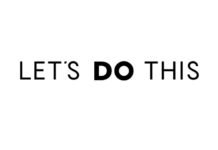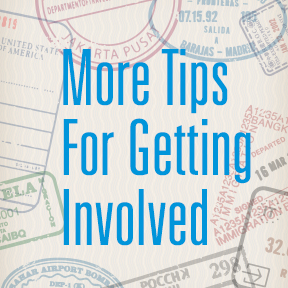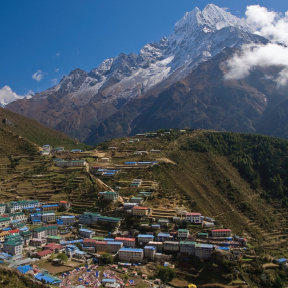
AN AWARD-WINNING DENTIST SHARES HIS STORY AND TIPS OF HOW TO SERVE AROUND THE WORLD.
Dr. Sherwin Shinn of Seattle, Washington, has spent the past 24 years dedicating a large portion of his life to humanitarian dentistry. Subsequently, he has traveled to more than 40 countries on 70-plus outreach trips, averaging about four trips per year. Because of his philanthropic efforts, Shinn has been recognized with such accolades as the Washington State Dental Association Citizen of the Year Award (2003), the National Jefferson Award (2007) Advancing Global Health Award, and most recently, the 2013 American Dental Association (ADA) Humanitarian Award.
When Dr. Shinn talks about his humanitarian work, he often describes it as a true “turning point” in his life. That’s because after he embarked down this philanthropic road, his life was never the same again. It all started in 1989, when Dr. Shinn was approaching his milestone 40th birthday. As his birthday drew closer, Dr. Shinn found himself questioning his life’s purpose. Until then, Dr. Shinn had worked hard to establish a life that he had always envisioned: he had a viable dentistry practice, a wonderful family, a beautiful home with all the ‘toys’ he could possibly imagine. He really did have everything. Yet, something nagged at him. Should he be doing more with his life?
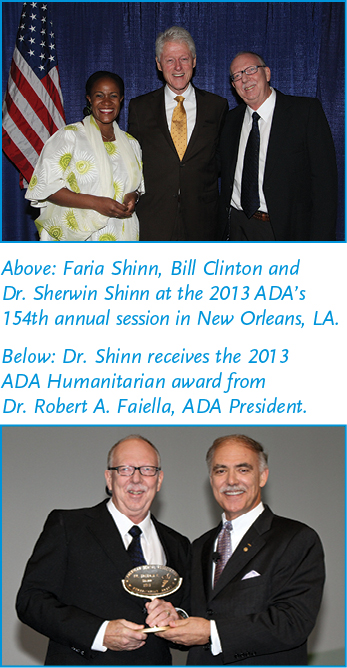 During that time of reflection, Dr. Shinn recalled the dreams of his childhood. Sure, he always wanted to be a dentist—he wanted to help raise people’s self-esteem by giving them smiles to be proud of, just like his dentist had done. However, Dr. Shinn also wanted a life of adventure. Growing up, Shinn’s next-door neighbor was the legendary James (Jim) W. Whittaker—the famed mountaineer who was the first American to scale the treacherous cliffs of Mount Everest and reach the summit. As a teenager, Dr. Shinn did all sorts of jobs and chores for Whittaker just to hear about his Himalayan experiences. “I just fell in love with his sense of adventure,” Dr. Shinn explained. “I always wanted to be like Jim Whittaker.”
During that time of reflection, Dr. Shinn recalled the dreams of his childhood. Sure, he always wanted to be a dentist—he wanted to help raise people’s self-esteem by giving them smiles to be proud of, just like his dentist had done. However, Dr. Shinn also wanted a life of adventure. Growing up, Shinn’s next-door neighbor was the legendary James (Jim) W. Whittaker—the famed mountaineer who was the first American to scale the treacherous cliffs of Mount Everest and reach the summit. As a teenager, Dr. Shinn did all sorts of jobs and chores for Whittaker just to hear about his Himalayan experiences. “I just fell in love with his sense of adventure,” Dr. Shinn explained. “I always wanted to be like Jim Whittaker.”
So, at the age of 40 years old, Dr. Shinn decided to do just that. He enlisted a group of likeminded climbing friends and started to plan an adventure of a lifetime to the Himalayas. At first, everyone was excited, but then (as things often go), the departure date neared and everyone else backed out for one reason or another. Dr. Shinn was not about to let this opportunity pass him by, so he decided to go to Nepal solo. “I just wanted to do it so badly,” Dr. Shinn explained. “I wasn’t going to let anything stand in my way.”
Six Weeks in Nepal
In 1990, Dr. Shinn embarked on his adventure. He caught a plane to Nepal—the “roof of the world” where eight of the world’s tallest mountains are located—and spent a total of six weeks hiking, climbing, and living amongst the region’s native people, the Sherpas. While there, Shinn was transported to another realm and totally forgot about his life at home—he was now Sherwin Shinn the adventurer and mountaineer! He was having the time of his life in this magical land, living out the dreams of his childhood. It was truly a vacation of a lifetime.
On his last day in Nepal, Dr. Shinn had two items on his agenda: visit a small field hospital and take a picture of the sunset over Mount Everest. As he made his trek towards the hospital, Dr. Shinn walked through a small village tucked into the rocky crevices on the edge of the cliffs. Suddenly, in the distance, he heard a child weeping miserably. The sound startled him. “The entire time I was in Nepal, I hadn’t heard a child cry once. Even though the people lived in very dire circumstances, none of the children cried or fussed. So, I knew instantly that something must be seriously wrong with this little one.”
Dr. Shinn followed the sound of the sobbing and arrived at the doorway of a humble shack. There, lying on the only bed in the room, was a little girl. The adults in the room stood over her, looking inside her mouth. “It was a strange experience,” Dr. Shinn explained. “I stood there for about a minute, as just an onlooker. I had become so entrenched in my time as a tourist, that I had totally forgotten about my profession.” Suddenly he was jolted back to reality. “I thought to myself, ‘Wait a second, I’m a dentist! I can figure out what is going on. I can be of some help,’” Dr. Shinn stated.
At that moment, he gingerly walked into the room so as not to startle anyone. As Dr. Shinn neared the bed, he saw the child’s condition. “The little girl was in bad shape. Her head was completely swollen—from her temples, all the way down her face, under her chin and into her armpits. She had a massive infection,” Shinn explained. “I knew right away that this was serious. It was a systemic infection that was going to be lethal if something didn’t happen for this child—immediately.”
In his very limited Nepali, Dr. Shinn tried to explain to the adults that he was on his way to the field hospital and he could take the child with him. At first, the adults shrugged him off and said that the girl’s condition was due to bad karma—her grandfather was an evil man and so she was doomed to have this horrible curse come upon her. Nothing could help her, they insisted. It was just a matter of time before she succumbed to her destiny. “I wasn’t there to change anyone’s beliefs or spirituality or anything. I just wanted to help this child. I felt it was my duty as a medical professional. I explained to them that I was going to the hospital anyway, so why not let me take her and maybe the doctors could do something to at least relieve some of the discomfort.”
Fortunately, the family agreed.
Scaling the Mountainside
Dr. Shinn immediately picked up the child and started towards the hospital. It was about a two thousand-foot climb up a steep, rocky trail from the small village to the clinic. He was already at eleven thousand feet, so the two thousand-foot climb was even more of a challenge since he was carrying the sick child. “I was really concerned that the exertion of going up the hill would cause more of the infection to spread into her system and that she might expire along the way,” Dr. Shinn explained. “I remember praying as I carried her, ‘Please don’t let this child die.’”
When he arrived at the field hospital, Dr. Shinn was shocked. The facility was very primitive and would hardly have been considered a clinic by most standards. Even in the United States, this child’s condition would require more than the level of care that a basic clinic would be able to provide: this child needed immediate surgery. “I explained to the medical staff about her condition. They were intrigued that I knew so much about what was going on. I explained that I was a dentist from the [United] States.” Their faces lit up when they heard this information. One staff member hurried out of the room and rushed back with a box full of supplies. “He said, ‘Oh good! You can take care of this!’ And he handed me a box,” Dr. Shinn stated. “That’s precisely what I was hoping not to hear, especially when I looked inside the small shoebox-size container and saw a dozen or so broken and corroded instruments. He also handed me a tube with Chinese writing on it and told me it was Novocain. I only hoped it was. I had no way to know for sure. Suddenly, I found myself in a very dicey situation that I was now solely responsible for.”
However, even though the conditions were not ideal, Dr. Shinn knew he had to get to work, immediately. There was no time to lose. He numbed the little girl’s mouth. Obviously, he couldn’t use any of the corroded tools in the box, so he pulled out his own pocketknife and used it to carve out the infected teeth. With the teeth removed, the open wound oozed excessively. Since no gauze could be found in the clinic, Dr. Shinn tore some strips of cloth to control the drainage. As soon as the teeth were out, Dr. Shinn said the little girl was like a different child. She was out of pain and anxious to get home. Dr. Shinn said, “Fortunately, they had some penicillin at the clinic, so I took some back with me to give to the family.”
Once the procedure was finished, Dr. Shinn and his young companion started making their way back to the village. From the plateau, he could see the rooftops of her village, two thousand feet below. “I remember looking down at the village and realizing how far we had to go. Instantly, I felt a surge of frustration. I wanted to take a photograph of the sunset over Everest and I was going to lose my chance, since it was already late in the afternoon. It was my last day in Nepal and I wouldn’t get the chance again. But as soon as I had those thoughts, a sudden wave of shame flooded over me. How could I be so selfish and think about a silly photograph when I just had the opportunity to use my professional expertise and skills to save a child’s life?” Dr. Shinn emotionally explained. As Dr. Shinn battled the feelings in his mind, the child wiggled out of his arms. She recognized her house in the sea of colorful rooftops and darted off down the trail towards her awaiting family.
If Dr. Shinn hadn’t witnessed this miracle personally, he wouldn’t have believed it was possible. Just a few hours before, the child had been near death. Now, she was racing down a steep mountain trail and even he—who was in good physical shape—had a hard time keeping up with her. At that moment, he realized the power of dentistry to transform lives. What he did that day really wasn’t too difficult for him. It was a simple procedure that took a matter of minutes—but it made a huge difference for this little girl. It truly saved her life.
While standing on that mountain trail, an idea struck him: He now knew why he had been drawn to the Himalayas. He wasn’t meant to go there solely for the fun adventures. No, he was meant to go there for a far greater purpose, which became clear as he looked down over the tiny Himalayan village. “This was what I had promised to do when I became a dentist. The Hippocratic Oath for Dentistry was something that I took very seriously. I had promised to use my skills and experience wherever, whenever and for whomever needed help. I knew that the people in those villages needed my help and I was determined to do what I could to help them.”
As Dr. Shinn hurried along the trail to keep up with the child, he made a commitment to himself. “From that second on, I wanted to help more people who were in desperate need of basic dental care,” he explained. He knew that the little girl’s dire situation could have been easily prevented if she had access to basic dental care and supplies. Something as simple as a toothbrush would have likely prevented the abscess from occurring in the first place.
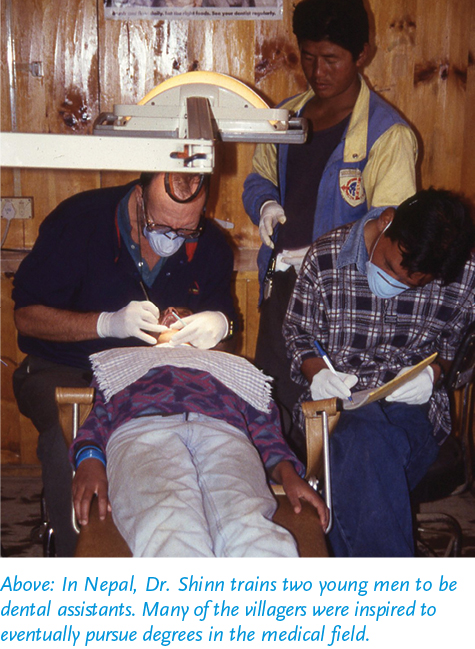 A Dental Destiny
A Dental Destiny
Over the next several years, Dr. Shinn returned to Nepal to be around the people whom he had grown to love. With him, he brought suitcases of dental supplies. He met with local schools and instructed teachers on the basics of dental hygiene. After four years of delivering supplies, Dr. Shinn decided it was time to help out further by building a permanent clinic in the area. He also assisted in setting up a system in the village to track the people and their dental care. He soon found that his desire to help was inspiring some of the local Nepalese people. “Several villagers took an interest in helping me. I gave them some basic training and they became my dental assistants,” Dr. Shinn explained. One profound experience was when one of the villagers who had been working as his dental assistant received a grant to go to dental school. This experience was particularly significant because the young woman was a relative of Sonam Chutin Sherpa, the girl whose life he had saved on his first trip (see photo, previous page). Life had truly come full circle and Dr. Shinn was pleased to have played a role in that cycle.
Today, more than twenty years later, Dr. Shinn still goes to Nepal and many other countries around the world doing humanitarian dental work. He frequently visits such locales as Costa Rica, Guatemala, Jamaica, Tibet, Uganda and the Cook Islands. In each place, he has established affordable field clinics with generators, air compressors, and the backup equipment required to do surgery, fillings, and other dental procedures. He also takes along volunteer groups who perform dental procedures during weeklong excursions.
Dr. Shinn stays active in several non-profit organizations that he has co-founded, including For World Wide Smiles and the 1000 Smiles Project. The latter group focuses its efforts primarily in Jamaica and has become the largest dental humanitarian outreach project in the world. “There are over 500 volunteer dental professionals who contribute their time to the program. During eight weeks in Jamaica, they see between eighteen and twenty thousand patients. This is an absolutely amazing number!” Dr. Shinn stated.
How to Get Involved
One of the greatest things that Dr. Shinn learned from his first experience in Nepal was that dreams and goals can come true if you’re willing to work hard to make them happen. “This is especially true in regards to humanitarian dentistry,” he explains. “If you have an inner drive or inner urge to do that kind of thing, if you have the confidence and the knowledge, you can make it happen.” However, while many people may have the desire to get involved, Dr. Shinn knows that many dentists often feel apprehensive for a variety of reasons. They might not know exactly where to start. They might not know which organizations are best suited for this type of work. They might fear that being away from the office for too long will negatively affect their business. For such hesitant peers, Dr. Shinn has some specific recommendations:
1. Choose a location. Dr. Shinn suggests, “First, decide where you want to go. Maybe there is a country you’ve always wanted to visit. I can guarantee that any place you go will have people who have problems with their teeth and will welcome your help.” You don’t have to go to war-torn locations to do humanitarian work, either. “Places like Hawaii and Fiji have people who could benefit from your services, too.”
2. Find groups that align with your goals. The next suggestion is for dentists to research humanitarian groups with programs that ring true to their personal goals. “The ADA has a great list on their website that provides dentists with a wide variety of options for organizations that do this type of work around the world” (see sidebar on page 43). Find out where the groups go and what their schedules are like. Dr. Shinn states, “Make some calls to these organizations. Ask questions. Then, make your decision on which group to sign up with or if you want to plan something on your own.”
3. Plan ahead. The third suggestion involves handling the time that dentists will spend away from the office doing humanitarian work. “Most dental practices are on a six-month recall timeframe,” Dr. Shinn explained. “So, look ahead six months and block out the time period that you want to go. It’s easier to block out a week or two in six months because you’re not booked out that far. Once you’ve booked the trip, don’t let anything interfere. Make a commitment and stick to it.”
When dentists book six months in advance, they will have plenty of time to prepare for the trip. “You have to consider the financial situation of not only your personal life but also of your employees. Exactly how are they going to get paid during that time period? Perhaps everyone can take vacation all at once. Or work extra days over the next six months to compensate for the lost time. If you’re on a four-day work week, then add extra Friday or Saturday appointments to make up for lost hours.”
4. Consider temporary help. Another tip that Dr. Shinn gives (one that many dentists might not have considered) is not to close the practice while they’re gone on trips. Exactly how is this possible? Use professional temporary agencies to find dentists who are willing to provide short-term help for your practice. “Bring them in six months in advance. Have them work with you for a couple of days. See if they have your same professional belief system and philosophy. See how well they work with your team and your patients. Once you have built a relationship with the dentist, you will be in a position to take a few weeks off once or twice (or maybe even several times) a year for humanitarian work. That way, you don’t have to close your practice.”
Some dentists may fear that their patients may not want a different dentist to work on them. “I have never found this to be a problem,” Dr. Shinn explains. “Generally, when I explain to my patients why I am leaving, they are more than happy to do what they can to help me—including being seen by a temp dentist while I’m out of town.” Dr. Shinn suggests that this particular method is a fantastic way to add humanitarian work into a practice. This is how Dr. Shinn goes on so many humanitarian trips every year. By keeping the doors of his practice open, the paychecks don’t stop for his team and the patients still get the treatment they need.
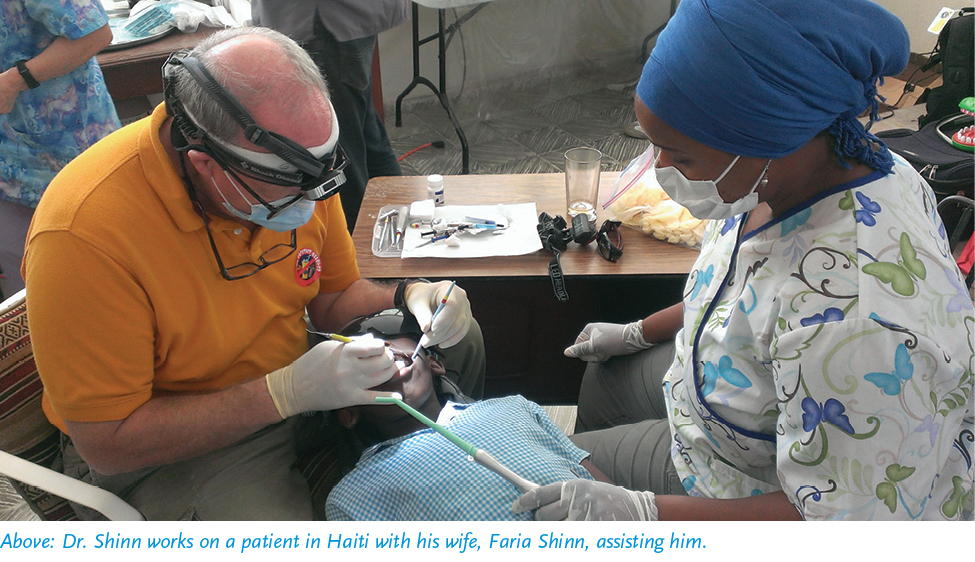 Boundless Benefits
Boundless Benefits
When you’re involved in something as fantastic as a dental humanitarian trip, the feeling is contagious and you can’t help but share the experience with others. At least, that’s what Dr. Shinn tries to do. He’s a firm advocate of sharing his humanitarian experiences with others—especially with his patients. When he’s on his trips, Dr. Shinn documents the experience by taking lots of photographs. Then, when he gets back, Dr. Shinn prints the photos and displays them as 8-by-10 images on his office walls and in a large photo album in the reception room. “I find that by doing this, my patients really get into the experience. This creates a memorable feeling in the office. You’re showing the patients, ‘Hey look, you’re helping us help these people because you support our dental practice.’” This lets the patients be part of the team. As Dr. Shinn puts it, “It lets them feel like they’re part of something greater than just coming in to get their teeth cleaned and examined.”
Without intending to, sharing the humanitarian experiences has increased business for Dr. Shinn’s office. “Our patients are really proud and they tell their friends about what we’re involved in. People will often respond with, ‘That’s really cool! I want to go to that office! I want to support that!’” Such enthusiasm has proven to be more profitable than any kind of advertising for the office. Dr. Shinn’s office attracts patients who feel like they are part of something unique and meaningful. All are service-oriented people who want to support the humanitarian goals of the office. Many of them give extra donations towards the humanitarian efforts in addition to the fees for their own dental work. This is a benefit that often accompanies dental offices that do outreach work. Such benefits result in a natural payback from putting good works into the world.
According to Dr. Shinn, one of the greatest benefits of humanitarian work is the education that dentists attain. “You get an education that you can’t get by doing anything else. You get to see what is happening in the world and why the world is the way it is. I have had so many empowering personal experiences that made my life happier, easier and more meaningful. I have observed how people of different cultures live day-to-day, how they treat each other, and how they handle life’s challenges. Had I not gone to these countries, I would have missed out on these experiences. My life would have been dull and a lot less happy than it is now.”
Looking back on his 20-plus years in humanitarian dentistry, Dr. Shinn simply can’t imagine a better life. It started with some key questions of self-evaluation on his pivotal 40th birthday. The questions led him to pursue a lifelong dream and serendipitously experience a moment in a small village on the rocky cliffs of the Himalayas that truly transformed his life. His message to his fellow dentists is simple: “Just remember, when you work for money, you get to have all the things that money can buy. When you unconditionally serve others, you get to have all the things that money can’t buy. My goal with my foundations is to help my fellow dentists experience a good portion of both of those things.”
CLICK HERE to read “More Tips for Getting Involved” from our Fall 2014 Issue.
For questions or to schedule a lecture about humanitarian dentistry and volunteerism, email Dr. Shinn directly at 4wwsmiles@comcast.net.

